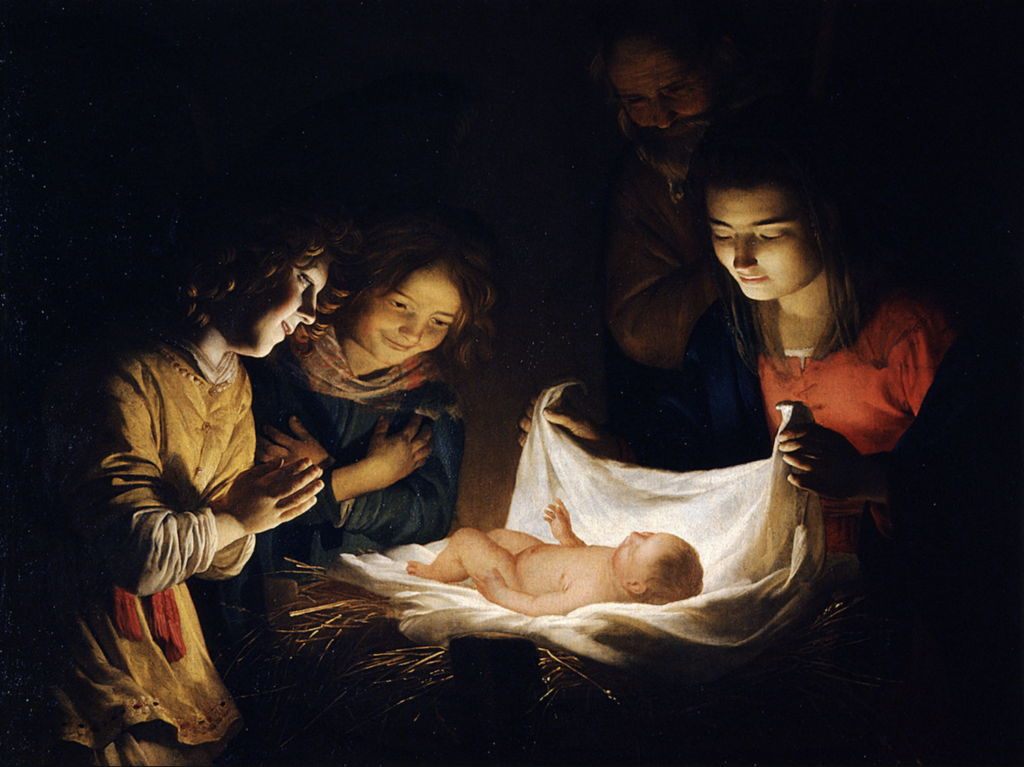



IMMANUEL
"Therefore the Lord Himself will give you a sign: Behold, a virgin will be with child and bear a son, and she will call His name Immanuel." ~ Isaiah 7.14
Immanuel. A Hebrew name meaning “God with us” was to be given to a child born during a time of great uncertainty and peril in Judah.
King Ahaz, faced with the prospect of a united attack from Israel and Syria, was searching for someone to protect him and his throne from certain destruction. He was contemplating seeking the protection of Tiglath-Pileser, King of Assyria.
The faithful prophet Isaiah warned Ahaz on seeking aid from the Assyrians, but rather pointed him toward the One who was eternally faithful and who had promised to always be with His people. Yahweh, the God who had rescued them from Egypt would also rescue them from the Syro-Israel attack. The God who had walked with them through the Red Sea would walk with them through a sea of conflict. The God who had walked with them through the wilderness would walk with them through the wilderness of war. Isaiah exhorted Ahaz to trust in God rather than trust in man. The young child, to be named Immanuel, would be a symbol of God’s enduring presence for the people of God.
The Apostle Matthew recognized in the birth of Jesus the fuller, perfect fulfillment of this prophecy and declared, “Now all this took place to fulfill what was spoken by the Lord through the prophet: ‘Behold, the virgin shall be with child and shall bear a Son, and they shall call His name Immanuel,’ which translated means, ‘God with us'” (Matthew 1.22-23). The Apostle John stated that, “The Word became flesh and dwelt among us” (John 1.14).
In Jesus, God came to walk with mankind, just as He did in the garden of Eden with Adam and Eve. He came to walk the same dirty, dusty roads; to endure the same hardships; to suffer the same temptations; to experience the human reality, so that He could become the perfect substitute on our behalf. Having experienced the same trials and temptations and victoriously overcome them all, He was able to be the perfect atoning sacrifice on our behalf.
One of God’s most frequent promises in the Old and New Testaments was that He would be present with us. Jesus is Immanuel. He is God with us.
Prayer
Thank you, Jesus, for your eternal and faithful presence in our lives. Thank you for walking with us in days of uncertainty. Thank you for walking with us in days of joy and victory. Help us to see your presence throughout each day; in the diminutive details, as well as in the moments of magnitude. Help us to trust your presence and not trust in our plans for our success and salvation. Amen.




Adoration of the Child (1619-1620) by Gerrit Van Honthorst
(oil on canvas; Uffizi Gallery, Florence, Italy)
The scene is one you might share from your own memory. It is the image of a mother, father and two children delighting in the sweet innocence of an infant. You too may have stood before a child, inhaling the scent that only newborns hold or marveling at the tiny fingers that grasp onto yours.
In this scene, a closer look reveals an incredibly young mother, not much older than the children standing with her and yet, in her face, she holds calm confidence and wonder. The father appears at least twice as old as the mother, his eyes brimming with happy tears.
And the two children hold their hands in prayer or blessing as they look in awe upon the child. Our eye, like theirs, is drawn to the infant, radiant, as if he himself is the source of light … and of course, he is.
Dutch artist Gerrit Van Honthorst depicts this intimate scene in his painting, “Adoration of the Child.” Van Honthorst came to Italy in the beginning of the 17th century, to copy Caravaggio’s chiaroscuro technique, the effect of contrasting light and shadow in painting.
Van Honthorst took chiaroscuro to a more dramatic illumination called tenebrism, where some areas of the paintings are left in darkness, as opposed to shadow. This work would influence another Dutch painter, Rembrandt. Van Honthorst became so skilled at the technique, the Italians gave him a new name, “Gherardo delle Notti” or Gerard of the Night Scene.
In “Adoration of the Child,” light is reflected off the faces of those gazing at the Christ Child. The child is in fact, the source of light in the painting. The edges of the scene are nearly in darkness reminiscent of John’s Gospel: “The light shines in the darkness, and the darkness has not overcome it” (John 1:5).
In the edges, in those shadows, we see the outlines of wings behind the children and realize that they are angels. These same angels will share the good news with shepherds tending to their flocks nearby, singing “Glory to God in the highest and on earth peace to those on whom his favor rests” (Luke 2:14).
Even though Mary is young, she shows none of the anxiety common to new mothers. This is the same young woman who told the angel Gabriel nine months earlier, “I am the handmaid of the Lord. May it be done to me according to your word” (Luke 1:38).
The red of Mary’s clothing reminds us of her royalty as the mother of Christ. She will watch her son, treasuring every moment in her heart.
In Joseph’s face, there is a tenderness; this child is who he’d been waiting for. Joseph had been told in a dream of the child’s impending birth. Joseph will devote the next years of his life protecting his son as they escape Herod and hide in Egypt. But in this moment, his heart glows in love and he understands all the prophets spoke of for centuries.
Behind the joyful sweetness of this scene lay foreshadowing of the future to come. The white linen the Christ Child is swaddled in, foretells the cloth in which his body will be wrapped, when he is taken down from the cross. He is a child born to die.
And what if you place yourself in this scene, as you have stood before children before, but this time, the infant is Christ. Can you smell the hay? The donkey dung? Or does the rest of the room fade to the edges? Do you fall to your knees? Do you glimpse glory?
Do you understand for a brief moment who you truly are? Do you understand the Word now that you see it in flesh? (online article in Catholic Magazine by Shemaiah Gonzalez t.ly/P3Iet)

Adoration of the Child (1619-1620) by Gerrit Van Honthorst
(oil on canvas; Uffizi Gallery, Florence, Italy)

Adoration of the Child (1619-1620) by Gerrit Van Honthorst (oil on canvas; Uffizi Gallery, Florence, Italy)

The scene is one you might share from your own memory. It is the image of a mother, father and two children delighting in the sweet innocence of an infant. You too may have stood before a child, inhaling the scent that only newborns hold or marveling at the tiny fingers that grasp onto yours.
In this scene, a closer look reveals an incredibly young mother, not much older than the children standing with her and yet, in her face, she holds calm confidence and wonder. The father appears at least twice as old as the mother, his eyes brimming with happy tears.
And the two children hold their hands in prayer or blessing as they look in awe upon the child. Our eye, like theirs, is drawn to the infant, radiant, as if he himself is the source of light … and of course, he is.
Dutch artist Gerrit Van Honthorst depicts this intimate scene in his painting, “Adoration of the Child.” Van Honthorst came to Italy in the beginning of the 17th century, to copy Caravaggio’s chiaroscuro technique, the effect of contrasting light and shadow in painting.
Van Honthorst took chiaroscuro to a more dramatic illumination called tenebrism, where some areas of the paintings are left in darkness, as opposed to shadow. This work would influence another Dutch painter, Rembrandt. Van Honthorst became so skilled at the technique, the Italians gave him a new name, “Gherardo delle Notti” or Gerard of the Night Scene.
In “Adoration of the Child,” light is reflected off the faces of those gazing at the Christ Child. The child is in fact, the source of light in the painting. The edges of the scene are nearly in darkness reminiscent of John’s Gospel: “The light shines in the darkness, and the darkness has not overcome it” (John 1:5).
In the edges, in those shadows, we see the outlines of wings behind the children and realize that they are angels. These same angels will share the good news with shepherds tending to their flocks nearby, singing “Glory to God in the highest and on earth peace to those on whom his favor rests” (Luke 2:14).
Even though Mary is young, she shows none of the anxiety common to new mothers. This is the same young woman who told the angel Gabriel nine months earlier, “I am the handmaid of the Lord. May it be done to me according to your word” (Luke 1:38).
The red of Mary’s clothing reminds us of her royalty as the mother of Christ. She will watch her son, treasuring every moment in her heart.
In Joseph’s face, there is a tenderness; this child is who he’d been waiting for. Joseph had been told in a dream of the child’s impending birth. Joseph will devote the next years of his life protecting his son as they escape Herod and hide in Egypt. But in this moment, his heart glows in love and he understands all the prophets spoke of for centuries.
Behind the joyful sweetness of this scene lay foreshadowing of the future to come. The white linen the Christ Child is swaddled in, foretells the cloth in which his body will be wrapped, when he is taken down from the cross. He is a child born to die.
And what if you place yourself in this scene, as you have stood before children before, but this time, the infant is Christ. Can you smell the hay? The donkey dung? Or does the rest of the room fade to the edges? Do you fall to your knees? Do you glimpse glory?
Do you understand for a brief moment who you truly are? Do you understand the Word now that you see it in flesh? (online article in Catholic Magazine by Shemaiah Gonzalez t.ly/P3Iet)

Playlist Daily Highlight
Take the time to listen . . . really listen to the words of this song. Reflect on them. Let God’s spirit speak to you in this moment.





